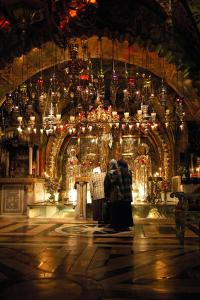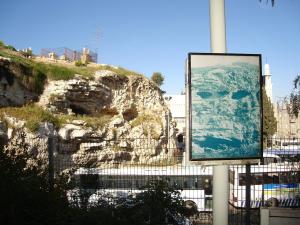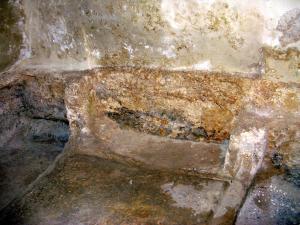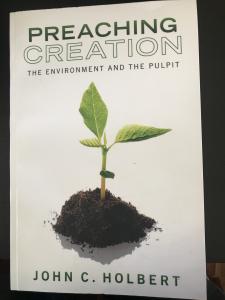D uring my first trip to Israel and Jordan, now 40 years ago in January, 1978, our small pilgrimage group from Ft. Worth, Texas, visited many of the traditional sites that such tours have long viewed. We went to the Sea of Galilee and its Church of the Loaves and Fishes and the Mountain of the Beatitudes. Moving south, we went to the Old City of Jerusalem, walking the way of the cross, ending up in the Church of the Holy Sepulcher, that since the fourth century CE has been the revered site of Golgotha, the Place of the Skull, where Jesus was crucified, buried, and resurrected.
uring my first trip to Israel and Jordan, now 40 years ago in January, 1978, our small pilgrimage group from Ft. Worth, Texas, visited many of the traditional sites that such tours have long viewed. We went to the Sea of Galilee and its Church of the Loaves and Fishes and the Mountain of the Beatitudes. Moving south, we went to the Old City of Jerusalem, walking the way of the cross, ending up in the Church of the Holy Sepulcher, that since the fourth century CE has been the revered site of Golgotha, the Place of the Skull, where Jesus was crucified, buried, and resurrected.
But on another day, we visited the Garden Tomb, a quite lovely site, not far outside the Damascus Gate of the Old City. Upon entry into the garden, we were greeted by two lovely British women, speaking a London-inflected English, who handed each of us a tiny olive wood cup and suggested that we move slowly and quietly through the garden, gazing at the supposed Hill of the Skull above the garden, ending our tour at the tomb where Jesus was laid and from which he was resurrected. If we so desired, they said, we could hold a brief communion service somewhere in the garden to commemorate our visit.
 The place was crowded that day, as the women said was true nearly every day. In the main, the other groups were rather more traditionally religious than was our group, since I was the leader, and had long been a skeptical scholar about such places. I had done some research about the site before we went, and had discovered several interesting tidbits of information, facts I shared with our group. This sharing was done amidst some often quite loud tears and cries from members of other groups who appeared to be quite overcome with religious fervor as they encountered the tomb which, so we all were told at the entrance to the garden, was in fact the actual tomb of Jesus of Nazareth. Indeed, it was made quite clear that that gaudy spot in the Church of the Holy Sepulcher, that we had already seen, could not possibly be the historical place of the Holy Week events for three simple reasons. First, the Bible is clear that Jesus had been executed outside the city walls; it was obvious that the ancient church was well inside those walls, and second, anyone could plainly see that the hill above the garden was skull-like with two prominent eyes, a hint of an empty nose, and the suggestion of a mouth below both eyes and nose; third, the tomb was just right and was, we were told from the first century CE and thus fit the Bible’s bill. And to top off those supposed historical “facts,” the place just looked right, a garden of trees and grass with a pleasant stream running through it. It was unfortunately situated right next to one of the main Jerusalem bus terminals, diesel fumes and motor noise adding little to the ambiance of the lush garden.
The place was crowded that day, as the women said was true nearly every day. In the main, the other groups were rather more traditionally religious than was our group, since I was the leader, and had long been a skeptical scholar about such places. I had done some research about the site before we went, and had discovered several interesting tidbits of information, facts I shared with our group. This sharing was done amidst some often quite loud tears and cries from members of other groups who appeared to be quite overcome with religious fervor as they encountered the tomb which, so we all were told at the entrance to the garden, was in fact the actual tomb of Jesus of Nazareth. Indeed, it was made quite clear that that gaudy spot in the Church of the Holy Sepulcher, that we had already seen, could not possibly be the historical place of the Holy Week events for three simple reasons. First, the Bible is clear that Jesus had been executed outside the city walls; it was obvious that the ancient church was well inside those walls, and second, anyone could plainly see that the hill above the garden was skull-like with two prominent eyes, a hint of an empty nose, and the suggestion of a mouth below both eyes and nose; third, the tomb was just right and was, we were told from the first century CE and thus fit the Bible’s bill. And to top off those supposed historical “facts,” the place just looked right, a garden of trees and grass with a pleasant stream running through it. It was unfortunately situated right next to one of the main Jerusalem bus terminals, diesel fumes and motor noise adding little to the ambiance of the lush garden.
My research had taught me that all three of the supposed historical reasons for believing this site was the actual one were in fact much in dispute. Careful archaeological work had demonstrated that the old church had been outside the walls of the city when it was first erected in the fourth century. The huge walls of modern Jerusalem were built some 500 years before our day by the famous Suleiman the Magnificent and were hardly the site of the original walls of the city. Second, the skull-like hill had been imaginatively exaggerated by those 19th century pilgrims who, disgusted by the gaudy and ungarden-like look of the ancient church, searched the area for a suitable replacement. Their discovery of the Garden Tomb was just the ticket. Perhaps most importantly, the tomb itself has now been shown to be as old as 8th-7th century BCE by a competent Israeli archaeologist. Hence, the tomb is hardly a “new” one as the Bible describes. In short, the Garden Tomb is a delightful and rewarding and financially successful tourist venue that has enriched the Garden Tomb Association, headquartered in England.
 Its history is quite interesting. Its most famous advocate was ‘Chinese” Gordon, a British general who, while returning from military struggles in China, stopped in Jerusalem on his way back to England. He was a deeply religious man, and carried a well-thumbed Bible wherever he went. When he saw the Church of the Holy Sepulcher, and all of its lamps and candles and incense, he could not square what he was seeing there with his image of the garden tomb as described especially in the Gospel of John. Hence, he sought another place more in line with his romantic notions of his own Bible reading. When he saw the current location of the Garden Tomb, he immediately wired his real estate agents in London and asked them to purchase the place, which they promptly did. This was 1883, so for the last 135 years the Garden Tomb Association of London has owned that special plot of Jerusalem ground.
Its history is quite interesting. Its most famous advocate was ‘Chinese” Gordon, a British general who, while returning from military struggles in China, stopped in Jerusalem on his way back to England. He was a deeply religious man, and carried a well-thumbed Bible wherever he went. When he saw the Church of the Holy Sepulcher, and all of its lamps and candles and incense, he could not square what he was seeing there with his image of the garden tomb as described especially in the Gospel of John. Hence, he sought another place more in line with his romantic notions of his own Bible reading. When he saw the current location of the Garden Tomb, he immediately wired his real estate agents in London and asked them to purchase the place, which they promptly did. This was 1883, so for the last 135 years the Garden Tomb Association of London has owned that special plot of Jerusalem ground.
It certainly did not trouble those English women at all that their claims to historical veracity had behind them a mere 135 years, while the Church of the Holy Sepulcher can claim a 1600 year history. This is not to say that there have not been some scholars who question even that site as the actual spot of the events of Holy Week. Still, the sites are two quite distinct and very different locations. Frankly, I care very little for those who think they must have an absolutely verifiable history to which to point before they are willing to place their trust in any so-called historical location. As I said in my lectionary post of this week, history for me will never be the final test of the importance of any place with connections to biblical events. It is the story that counts for me, not some disputed historical attestation. My faith is not ever constructed on the weak foundation of possibly unverifiable data of history.
As I look back through my forty years of ministry since I first saw “Gordon’s Calvary,” the site’s nickname, I now feel I was far too harsh in my dismissal of the place as a grotesque tourist trap. So many that day, and in all the days that followed I am convinced, found a deep well of emotion as they imagined the suffering and death of Jesus. Indeed, as they stepped into the tomb, not knowing that it was not a first-century one, they wept very honest and heart-felt tears for the one they called Christ. Who am I to judge them in their historical ignorance? I feel about this Hill of the Skull as I feel about Yardenit, a beautiful site near the Sea of Galilee that was built by the Israelis to accommodate the many pilgrims who long for a watery baptism or a renewal of baptism in a place that matches their romantic ideas of what a baptismal site should look like. The fact that it has absolutely nothing to do with any historical event of Jesus is quite beside the point, I now believe. If I believe it is the story that contains the power to move and guide believers, and I surely do, then wherever the location of some place or other may be is finally irrelevant.
The story of Holy Week is never tied to any one place in our world. It is the story of the gift of love for the whole world, the suffering of a person for what he believed in even until death, the triumph of God over the ravages of death, and the gift of life from that same loving God. In short, it is the story we all need to hear again and again, and no argument about the locale of its actions will stop its power to heal and save.
(Images from Wikimedia Commons)











